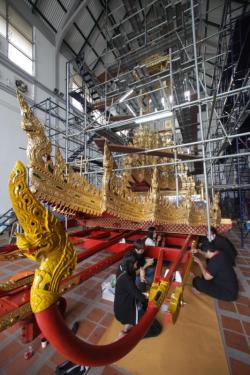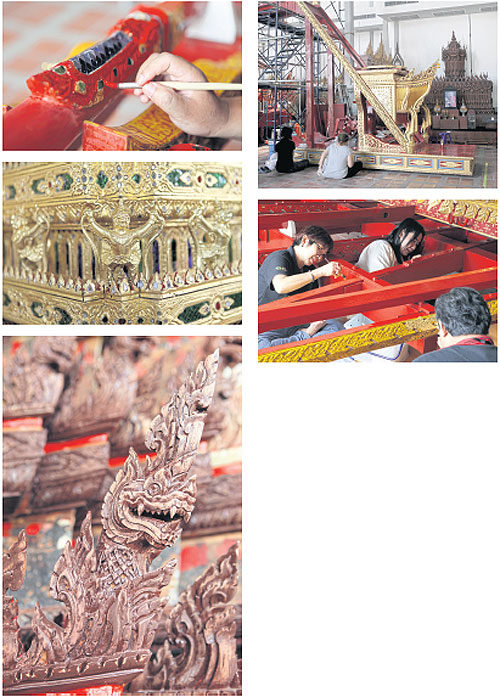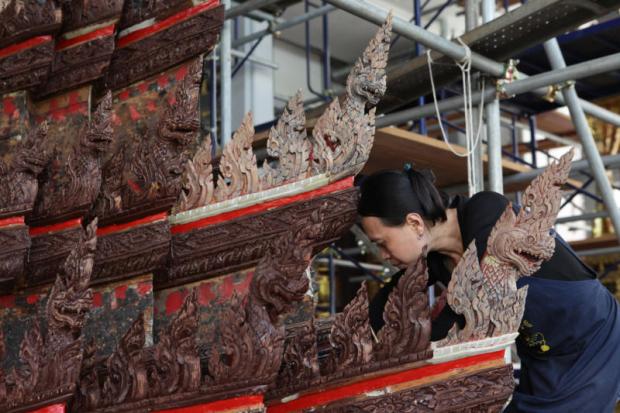Like a journey through clouds towards heaven, marvellous royal chariots and vehicles will be moving smoothly and gracefully around the Grand Palace and Sanam Luang in a stunning procession for the royal funeral of the late King Bhumibol Adulyadej on Oct 26. Amid great sorrow and mourning, everyone will be mesmerised by the grandeur of the royal ceremonies befitting the great king.
"The royal funeral ceremony for His Majesty the late King Bhumibol Adulyadej requires the use of royal chariots and vehicles in the procession to bring the royal urn from Dusit Mahaprasart Throne Hall, the Grand Palace, to the royal crematorium, Sanam Luang, for the royal cremation and later bring the bones and ashes from the crematorium to the Grand Palace," Anandha Chuchoti, director-general of the Department of Fine Arts, stated in the department's book entitled Royal Chariots And Royal Vehicles.
Royal chariots and vehicles are among of the royal paraphernalia for monarchs and the royal family and reflect the titles and positions of users. The use of royal chariots and vehicles has been a tradition since ancient times. Clear evidence of this tradition in the Ayutthaya Period was also found.
In the reign of King Rama I of the Chakri Dynasty, seven royal chariots were built for the royal cremation of the king's father in 1796. The seven are Phra Maha Pichai Ratcharot, Wechayanta Ratcharot, three Ratcharot Noi and two smaller chariots for carrying scented offerings.
These chariots have long been used for royal cremations and kept along with other equipment in the Royal Chariot Storage in the National Museum Bangkok compound. However, it is a tradition for people to not repair and maintain royal chariots without the death of a royal since preparations can be bad omens. According to a Buddhist belief, a king is a Bodhisattva who will reincarnate as the future Buddha. Being a king is the opportunity to do good deeds to accumulate merit and charisma to be reborn as Buddha. According to a Brahman doctrine, a king is an avatar of the three mighty gods: Brahma, Shiva and Vishnu. The death of a king means his return to heaven.

The restoration of the royal chariots, vehicles and equipment for the royal funeral is under way. Jetjaras Na Ranong
Royal funeral ceremonies are an act to honour a deceased king and see him off on his way to heaven, so they must be prepared and performed strictly according to protocol and procedure.
Apart from the construction of the royal crematorium, preparations for the procession of the royal urn and royal paraphernalia are also important. The royal chariots, vehicles and palanquins as well as rehearsals must be well-prepared to ensure the procession goes smoothly.
To prepare the royal chariots for the funeral of King Bhumibol Adulyadej, eight artisans from the Department of Fine Arts and about 20 volunteers work every day to fix royal chariots and palanquins. Before starting daily, they bring garlands to pay respect to Phra Maha Pichai Ratcharot, which will bring the royal urn from the Grand Palace to the royal crematorium at Sanam Luang.
"Mirror glass has been in a deteriorating state since the last restoration [of Phra Maha Pichai Ratcharot] was done 30 years ago, but gold decoration is still in perfect condition. So, we have been fixing damaged parts only. The volunteers help cut mirror glass and apply it to the pillars of the royal chariot while the artisans do the rest," said Yunee Teeranun, an art specialist for the department and deputy chairperson of the royal chariot restoration committee.
Phra Maha Pichai Ratcharot -- the greatest chariot -- is in the shape of a busabok (a tall structure with multi-tiered, pointed roof). It was carved from wood and decorated with lacquer, gold leaf and mirror glass in the reign of King Rama I. It sports the exquisite wooden sculptures of a naga and numerous Thai motifs, as well as embroidered royal umbrellas. It is 4.88m wide, 18m long, 11.2m high and weighs 13.7 tonnes. To move it, 216 officers and five controllers must pull specially-made ropes.
It was first used in 1796 and later carried the royal urns of several earlier kings, queens and high-ranking royals, including King Rama I and his queen; King Rama II and his queen; King Rama III; King Rama IV and his queen; King Pinklao; King Rama V; King Rama VI; the Princess Mother; HRH Princess Galyani Vadhana; and HRH Princess Bejaratana Rajasuda.

Phra Maha Pichai Ratcharot is seen during the funeral of King Rama VI. Fine Arts Department
One of the three Ratcharot Noi (small royal chariots) has been chosen for the forthcoming royal funeral. It is also in the shape of a busabok and was built in the reign of King Rama I. Carved from wood and decorated with lacquer, gold leaf and mirror glass, it is 3.86m wide, 12.95m long and 6.84 high and weighs 3.65 tonnes. A total of 74 officers and five controllers are required to manoeuvre it. It serves as the "chanting chariot", leads Phra Maha Pichai Ratcharot and carries the Supreme Patriarch, or a senior monk who prays all the way from the Grand Palace to Sanam Luang.
The other royal vehicles and equipment to be used during the royal funeral are two Rachentharayan vehicles, two Phra Yannamart Samlamkhan (three-beamed palanquins) and two Kren Bandai Nak (naga-shaped staircases).
Kren Bandai Nak were invented by Prince Jui (Krom Luang Pithakmontri), son of King Rama I's elder sister, Princess Krom Phra Srisudarak. They were used for the first time during the royal cremation of Rama I in 1812. They look like an escalator, with the naga-shaped railings, and have space and mechanisms for placing and moving up and down the royal urn. For the royal funeral, one is for lifting the royal urn from Phra Yannamart Samlamkhan to Phra Maha Pichai Ratcharot outside Wat Pho and the other for bringing the royal urn from Phra Maha Pichai Ratcharot at Sanam Luang.
Phra Yannamart Samlamkhan (three-beamed palanquin) will be used to carry the royal urn from the Grand Palace to the pavilion east of Wat Pho, while Ratcharot Puen Yai (a cannon-equipped chariot) will carry the royal urn around the crematorium in the circumambulation ceremony.
The restoration of Phra Maha Pichai Ratcharot began on Jan 9 and is due to be completed by the end of August, while Ratcharot Noi, which needed an overhaul, is being mended. One Rachentharayan for taking the cremated bones of the late king from the crematorium to the Grand Palace is being mended while a new one is being built for carrying the royal ashes.
Yunee recalled that she started her work to restore the royal chariots, vehicles and palanquins in 1996 for the royal funeral of the late Princess Mother.
"I am a gold leaf and mirror-glass decoration artisan and also oversee such work for the royal chariot repairs. I have had opportunities to do this job on every major occasion, allowing me to learn more and improve my skills," she said, "We work 9am to around 7pm on weekdays and 9am-5pm on weekends. All the volunteers are willing to help."
Phayung Meechokchai, a mirror-glass artisan of the Department of Fine Arts, has repaired the royal chariots since the preparations for the royal cremation of Queen Rambhai Barni of King Rama VII in 1985. She said proudly yet sadly: "It is a great honour for me to do this task."
Noppadol Olarn, a royal chariot repair volunteer who had volunteered to assist artistic work for the royal funeral of the late Princess Mother, said about 20 volunteers, who mostly have Thai painting degrees, take turns to repair the lacquer foundation and apply gold leaf and mirror glass to the main royal chariot.
"The only difficulty is limited work space that requires us to bend down, stand up and bear the heat, which increases near the top of the chariot. The cool air from the air conditioner cannot reach the high ceiling," he said. "We are proud to serve King Rama IX for the last time."



